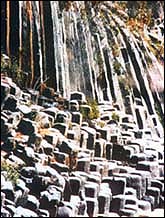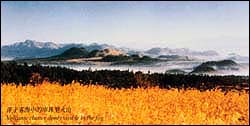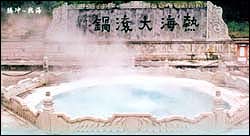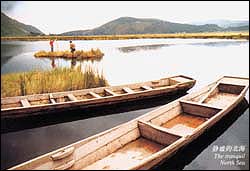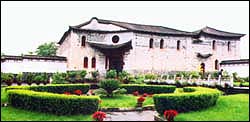| Tools: Save | Print | E-mail | Most Read |
| Tengchong Hot Springs |
| Adjust font size: |
Tengchong has a stunning volcanic landscape that includes natural volcanoes, Volcanic Landscape:
The county itself lies on the lava lands of A casual stroll around the small volcanoes followed by a dip in a hot spring give you a good taste for the area.
In the volcano park, there are eight well-preserved volcanoes from the Cenozoic era. The foremost is Daying (Beat Hawk) Mountain, which sits in the middle part of the county, and has erupted many times. It is the tallest conical volcano in the area, rising 2,614 meters, and is surrounded by over 70 volcanoes of different sizes. About 10 kilometers to the north stands Dakong (Senior Empty) Mountain, Xiaokong (Junior Empty) Mountain and Heikong (Black Empty) Mountain. The environment in Tengchong includes many different types of volcanoes, as well as magnificent scenes such as volcanic lakes, crater lakes and lava cascades. Taken together, these comprise the biggest natural museum of dormant volcanoes in Admission fee: 20 yuan Activities: visitors can take a fire balloon at the foot of the volcano. Cost: 100 yuan. Transportation: Take bus route C (10 yuan) or hire a taxi (around 40 yuan). A World of Heat Visitors cannot miss a trip to Rehai (
Among the numerous smaller springs and geysers, the park also has cooler springs suitable for a swim, including Frog Mouth, Lion Head, Pearl Spring and Drum-beat Spring. The waterfall on the Overall, Tengchong has more than 80 Admission fee: 20 yuan Transportation: Take the bus in the county or a taxi. (Both cost 5 yuan/person). It's not recommended to hire a bicycle since it is quite tiresome to ride on the winding mountain road. Lodging: Tengchong has some hotels but it is better to reserve a room in the busy season. Standard rooms are 268 yuan but can be bargained down to about 90 yuan in the low season. Hotels: Rehaimingzhuren Hotel: (Tel) 0875-5149888 Standard room: 220 yuan Rehairen Hotel: (Tel) 0875-5150366 Standard room: 180 yuan (Spa included) Laogunguo Inn: 10 yuan. (This one is cheaper but visitors have to walk about 10 minutes to get to the park) Admission fee: 10 yuan, plus 54 yuan for the cable car Beihai National-level Protected Wetland
The surface of the lakes is covered by one-meter-thick grass decorated with many wild flowers, but be careful of drowning while stepping on the grass; the water beneath is about seven meters deep. Boating on the river and fishing is a good way to relax. Admission Fee: 20 yuan Transportation: the wetland is 12 kilometers away from the county. A minibus costs 5yuan person. It is about 20 minutes bus ride.
Transportation: The township is only four kilometers away from Tengchong. Hiring a taxi costs 10 yuan. Lodging: it is quite cheap to stay in Heshun. It costs about 10 to 20 yuan. Tomb of State Funeral The tomb of State Funeral lies one kilometer southwest of the county. It is the largest, and best-preserved Admission Fee: 10 yuan Transportation: The tomb of State Funeral lies within the county; visitors can walk to the site. General Travel Info: --The nearest airport is in Baoshan, a two-hour bus ride from Tengchong. Visitors may take a flight from Beginning April 28, travelers in --A taxi for a day that includes --Tengchong Hotel is a good deal. Standard rooms are 268 yuan but can be bargained down to about 90 yuan in the low season. More About Tengchong Geography: Tengchong, tucked in a western corner of Located on the border of the Europe-Asia continental plate, Tengchong is a highly volcanic area. Since 1500, there have been over 70 earthquakes in the area measuring five or more on the Richter scale. The Daying (Beat Hawk) Mountain volcano has erupted many times. Ma'an Mountain consists of three volcanoes, some of which have formed lakes. Tengchong has the best preserved volcano groups from the Cenozoic Era in History: The history of Tengchong can be traced back to the Han Dynasty, around 100 BC. For 2000 years, it was an important station along the old southwestern silk route. Xu Xiake, a great Ming Dynasty traveler, described the place as the "number one furthest city on the border". The Han and 22 ethnic minority groups reside in the county. (For more knowledge about The place also boasts as "the cradle of Tengyue culture," a hybrid culture mixing Han Chinese, local ethnic minority groups, and foreign cultures from Local products: Tengchong was renowned as the Jadeware factory of Local people work jadeite into bracelets, earrings and many other decorations. In its golden days, during the Ming and Qing dynasties, there were more than 500 jadeware workshops and over 3,000 craftsmen in Tengchong. The local Duanjia, Wangjia, Qiluo and Zhengkun jade works - named after their makers - are well known at home and abroad. Tengchong is also famous for producing traditional Chinese herbal medicines, Xuan paper (high quality paper for traditional Chinese painting) and rattan work, which is famous throughout Transportation: Tengchong, though a small city, has been an important link between southwest It
opened to foreign trade during the Qing dynasty and was deemed important enough by the British to establish a Consulate there. The first consul arrived in 1899 and the office remained open until the 1940s. In the first decades of this century, the main route from Dali to The building of the Today, this remains the primary highway in western (CRIENGLISH.com November 10, 2006)
|
| Tools: Save | Print | E-mail | Most Read |
 |
| Related Stories |
|
Product Directory China Search |
Country Search Hot Buys |
